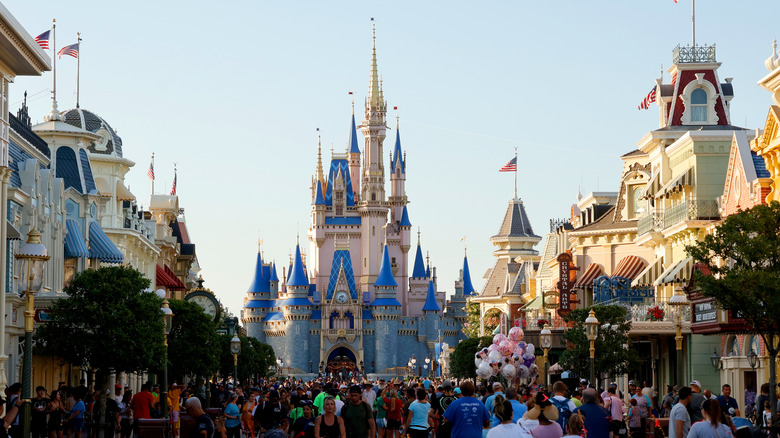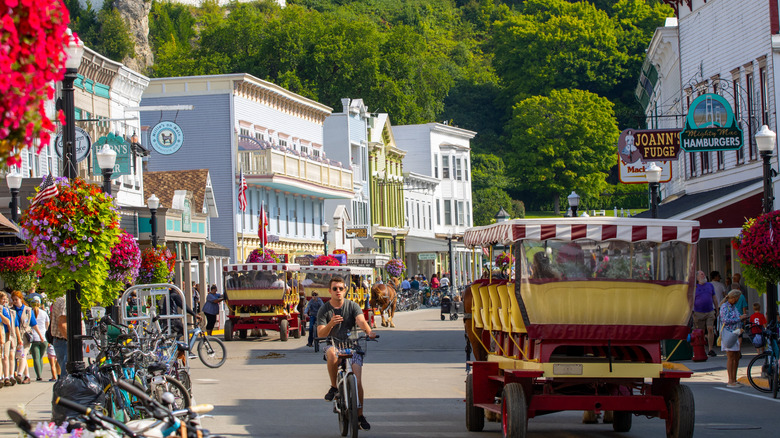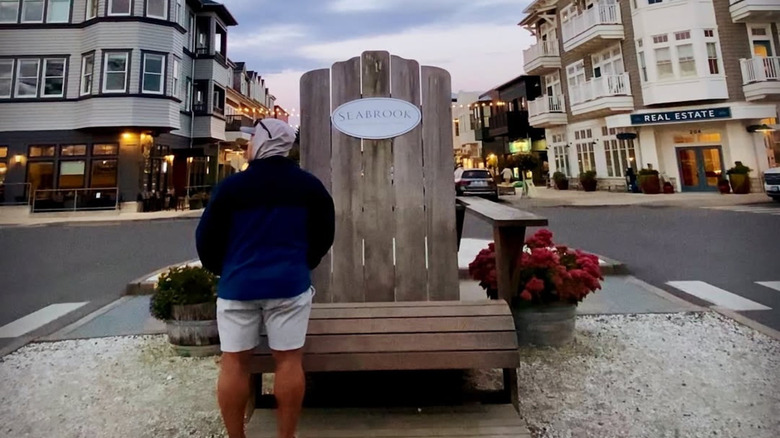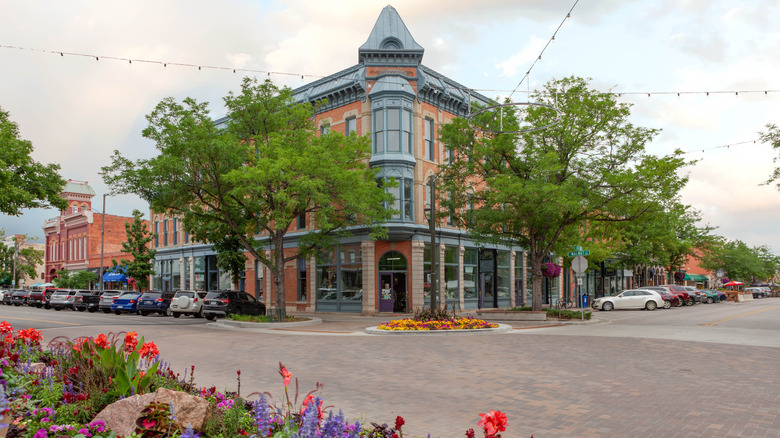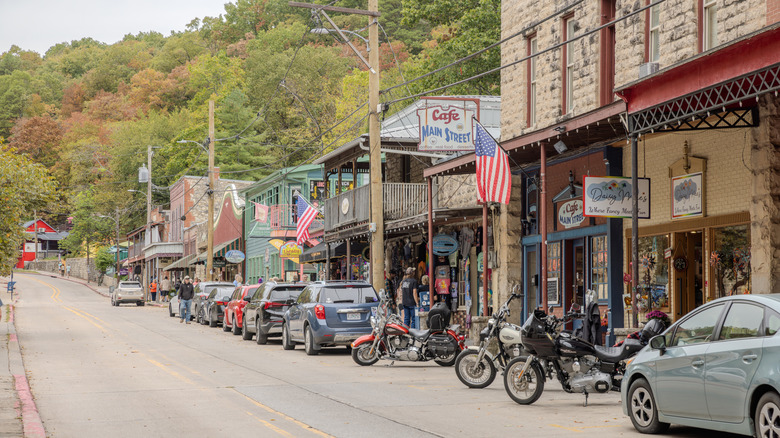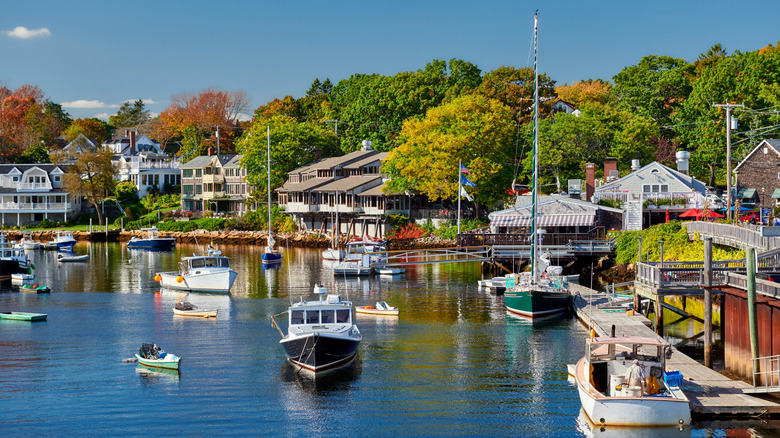Places Disney Fans Should Visit To Feel The Magic Of Main Street, USA That Aren't In A Theme Park
After scanning your tickets, Main Street, U.S.A., is the first area you enter in most Disney theme parks. With classic features like cobblestone streets, decorative shopfronts with neon signage, and flag-topped lamp posts, each Main Street shares a similar concept but has its own unique features. If you're a Disney fan yourself, you'll know that Main Street was inspired by real, historic streets in America, designed to evoke the magic and nostalgia of small-town life in the 1900s. This blend of fantasy and reality is a concept used throughout Walt Disney's parks, just like Sleeping Beauty's Castle, which was inspired by the Neuschwanstein Castle built in 1869.
The first Main Street U.S.A. opened in 1955 at the original Disneyland in Anaheim, California. Today, there are six major Disney resorts, each featuring its own version of Main Street, U.S.A., with the exception of Tokyo Disneyland and Shanghai Disneyland. These areas typically serve as the central hub of the park, offering a range of dining options, galleries, and themed shops in buildings designed to resemble classic early 20th-century buildings like a City Hall, a barber shop, and an ice cream parlor.
The thing is, visiting a Disney park isn't financially possible for every American. A one-day ticket to one Disney World, for example, averages around $154 per person, not including food, transport, or the quirky souvenirs that often define the experience. Instead of spending thousands at Disney (though there are ways to make your Disney stay more affordable), consider visiting one of these five American towns. They might not have a majestic castle at the end of the street, but they sure do offer the magic and nostalgia of Main Street, U.S.A., without being in a theme park. This list isn't exhaustive, but each town was chosen for its thoughtful layout, classic all-American storefronts, and scenic setting.
Mackinac Island, Michigan
At the intersection of Lakes Michigan and Huron, two of North America's five Great Lakes, lies Mackinac Island, often called the Jewel of the Great Lakes. Technically located in Michigan on Lake Huron, the island was originally a burial ground for the ancient Indigenous Anishnaabek tribe. It later passed through French, British, and American control before becoming a U.S. territory in 1815, and eventually, a resort destination.
Today, Mackinac Island, home to only 500 year-round residents, feels frozen in time, which is exactly what Disney aims to create with their Main Streets. It's one of the only cities in America where cars have been banned, a law that has been in effect since 1898. Instead, visitors travel by horse-drawn carriages and bicycles along the island's short 8-mile coastline. There are no chain stores on the island, adding to the sense of escape, and the island's geography keeps it naturally cut off from the mainland. The only way to access Mackinac is by ferry connections from St. Ignace and Mackinaw City in Michigan (or by private plane).
The town's iconic accommodations add to the timeless feel. The Bay View Bed and Breakfast is set in an iconic Victorian house built in 1891 overlooking the bay. Still today, its interiors and personalized service celebrate a turn-of-the-century aesthetic with bold wallpapers, floral linens, and draped curtains. Offering a similar atmosphere on a larger scale, the Grand Hotel was the island's first accommodation to welcome summer visitors from Detroit and Chicago in 1887. Back then, a room would cost $3 to $5 a night. With its colonial-style white columns, the hotel remains a quintessential symbol of Americana. It even has seven suites named after the country's most iconic First Ladies.
Seabrook, Washington
Seabrook in Washington is another real-life town that mirrors the feel of Disney's Main Street U.S.A., though not for the reasons you might expect. Founded in 2004 by Casey Roloff, it's a well-planned project rooted in the unique concept of new urbanism. Inspired by a similar purpose-built town in Florida, Seabrook is designed as a walkable, sustainable town with parks, shops, facilities, and easy outdoor access. It even has a concierge that handles everything from grocery deliveries to restaurant reservations, essentially functioning like a town-wide resort with built-in guest services.
Over the past two decades, Seabrook has grown into a community of more than 500 new houses spread across nine small neighborhoods. Half of the houses are rented as holiday homes, and the town releases new neighborhoods just like a hotel would release a new wing. The goal was to reimagine small-town America living by combining the best elements from the last century of city planning. It's an easy two-and-a-half-hour drive (138 miles) from Seattle, or a three-hour drive (172 miles) from Portland, Oregon.
Responses to the town have been mixed. One visitor described it as, "Stepford creepy, tacky, and completely out of place." Another called it a "carefully constructed simulacrum of a town that allows the privileged and the wealthy to live out the fantasy of living in a small town while actually living in what is in essence a giant condo complex." On the other end of the spectrum, in a Yelp review, Jason V said, "Seabrook is as close to idyllic as one can imagine a town could be. It's clean. It's safe. It's the American Dream as pictured on a postcard." Whether dystopian or idyllic, Seabrook captures the structured feel of Disney's Main Street in a very real-world setting.
Fort Collins, Colorado
Tucked away at the base of the Front Range of the Rocky Mountains, just 65 miles north of Denver, Fort Collins is often considered one of Colorado's less-touristy cities. But unlike others on this list that resemble Main Street U.S.A., Fort Collins is the only one that directly inspired it. Walt and his art director, Harper Goff, who grew up in Fort Collins, based the original Main Street on the City's Old Town. This historic district features 20 preserved and restored buildings that now house locally owned boutiques, over 130 dining establishments, charming outdoor patios, and public art installations, all of which helped shape Disney's vision.
Recognized as the Cultural Capital of Northern Colorado, Fort Collins thrives on creativity and community. Ballet, theatre, and opera performances fill the town with energy year-round. Pedestrian-only streets are strung with lights, musicians play on corners, and the atmosphere is welcoming and authentic. There is even a stage where performances and free concerts are held. One of the historic district's oldest restaurants, Silvergrill Cafe, has been serving iconic, giant cinnamon rolls to customers at its original location on Walnut Street since 1933.
Among other iconic buildings that look like they fell straight out of Main Street U.S.A. is a 1912 post office, now the Museum of Art, a historic school dating back to 1907, and two churches, including the First Baptist Church from 1903, which is still operating today. Consider staying at Edwards House, a Neo-classical foursquare bed and breakfast built in 1904 within walking distance of Old Town. The property became a bed and breakfast in 1993 and offers nine timeless suites.
Eureka Springs, Arkansas
Visiting Eureka Springs feels like stepping into another era. It's the quietest town on this list, purely because it's so far off the beaten track. Deep in the Ozark mountains, equidistant from Kansas City and Oklahoma City, this small Arkansas town is about a four-hour drive from either city. This unique city with mountain charm is home to just 2,000 permanent residents, 300 of whom are working artists. With its strong creative energy and LGBTQ+ friendly community, it's as much an art colony as it is a mountain escape. The town even has its own performing arts venue –– the Eureka Springs City Auditorium (also known as "the Aud"), which seats nearly half the town's population.
As a major contender as a town with a Main Street U.S.A. feel, the 2-mile stretch in the Historic District is known for its preserved Victorian buildings, 25 boutique shops, and retro painted signage from a century ago. The street is lined with classic American businesses like Mud Street Cafe Annex, the go-to spot for breakfast, a neon-lit corn dog stand, and the Two Dumb Dames, a fudge and candy store with its original rickety metal signage. Tripadvisor Reviewer Sean R. may have said it best: Eureka Springs is "one of the best well-preserved Victorian historic districts in the United States, you'll find interesting and quirky stuff around every corner. Restaurants, historic hotels, bars, art galleries, and shopping for all ages."
It's also relatively easy to explore. A tram system runs four color-coded routes throughout the town for a $6 all-day pass. There are 600 parking spaces on the street and in lots, although on busy weekends, visitors do mention that parking can be tricky.
Ogunquit, Maine
Ogunquit is the only seaside town on this list. It's located along Maine's Southern coastline with a long sandy outer bank and grassy dunes at a beach rated as one of the best in the country according to Tripadvisor travelers. The name comes from the Abenaki Native American word meaning "beautiful place by the sea," and it sure does fit the bill. Like much of New England, the town's classically overpriced real estate, lack of houses on offer, and average household income above $185,000 mean it is home to just 1,500 full-time residents, a fact that only adds to the town's surreal, old-school feel.
Rather than a classic Main Street, the area here that resembles Disney's Main Street is Perkins Cove. It's a protected natural inlet of calm water, bobbing boats, and historic whitewashed houses along the aptly named Shore Road and Harbor Lane. Some of the oldest buildings include the Romanesque-style Memorial Library from 1897, the Ogunquit Playhouse, which was built in 1933 and is still running today, and the artist-founded Barn Gallery, a historic meeting place since 1928. The town is dotted with nostalgic seafood shacks like the Ogunquit Beach Lobster House and fluttering American flags that send it straight into the Main Street U.S.A. category.
Ogunquit was first settled in 1641 and later founded as an independent artists' colony in 1888. It remained a sleepy outpost of artists and sailors until the tourism boom of the 1980s. Some inns and boutique bed and breakfasts popped up to accommodate the summer crowds, who had gotten word of the peaceful town. However, it still has that quiet magic that Main Street U.S.A. aims to achieve.
